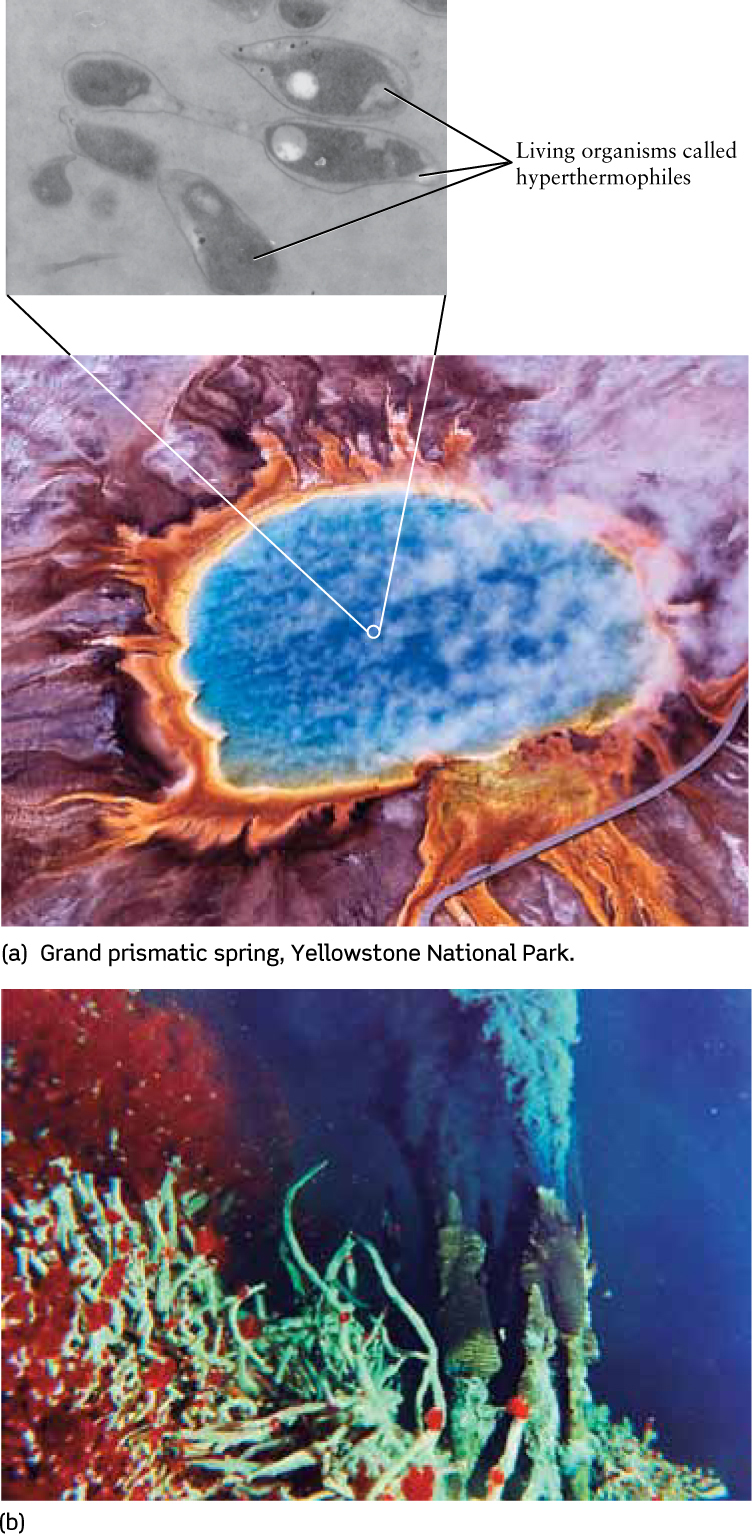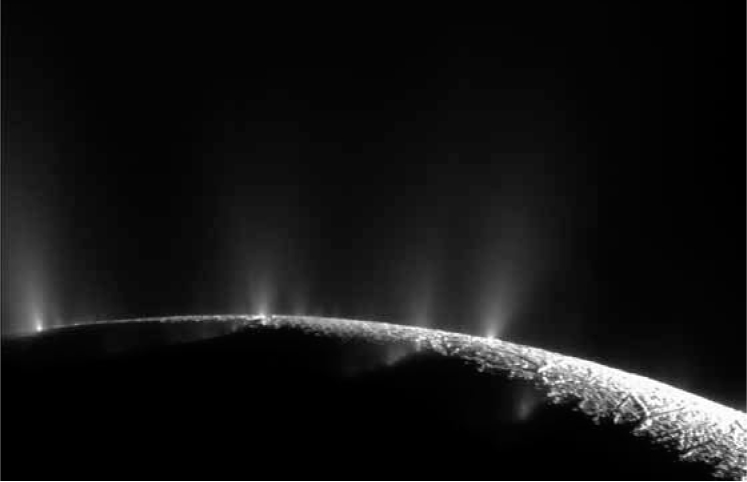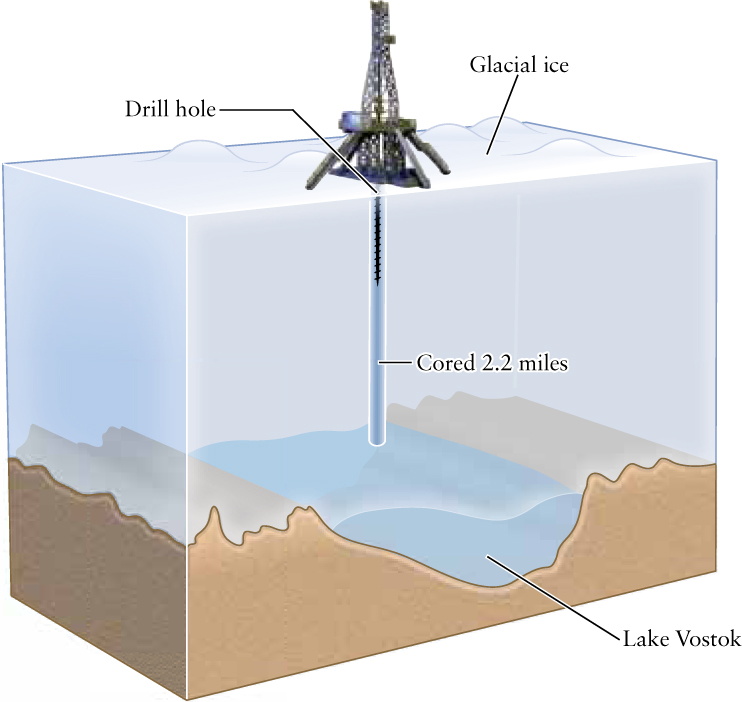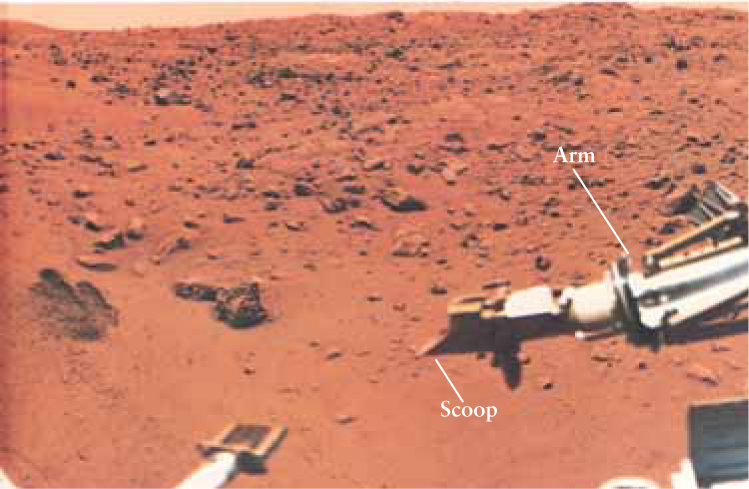27-2 Water and the potential for life
If life evolved on Earth from nonliving organic molecules, might the same process have taken place elsewhere in our solar system? Scientists are carefully scrutinizing the planets and their moons in an attempt to answer this question.
The Importance of Liquid Water
One major constraint is that liquid water is essential for the survival of life as we know it. However, the water need not be pleasant by human standards—terrestrial organisms have been found in water that is boiling hot, fiercely acidic, or ice cold (see the image that opens this chapter)—but it must be liquid. Organisms living in such extreme conditions are called extremophiles, such as the thermophiles that thrive at high temperatures (Figure 27-5). Other extremophiles include microorganisms that are resistant to high levels of nuclear radiation, and those that live within the tiny porous spaces inside of rocks. All known life-forms require at least some liquid water, and even the extremophile microbes living within ice contain a form of antifreeze to keep their internal water liquid.

Extremophiles Can Take the Heat (a) These microscopic thermophiles (heat-loving organisms) live in water that is between 80°C and 100°C (85°F–140°F). (b) Tube worms (light-green tubes) with hemoglobin-rich red plumes. They reside around black smokers—vents in the ocean bottom that are in the same temperature range as the hot springs shown in (a). These vents are more than 3 km (2 mi) under water.
In order for water on a planet’s surface to remain liquid, the temperature cannot be too hot or too cold. Furthermore, there must be a relatively thick atmosphere to provide enough pressure to keep liquid water from evaporating. Of all the worlds in our present-day solar system, only Earth has the right conditions for water to remain liquid on its surface.
The Oceans of Europa and Enceladus
There is now compelling evidence that Europa, one of the large satellites of Jupiter (see Table 7-2 and Figure 7-4), has an ocean of water beneath its icy surface. As it orbits Jupiter, Europa is caught in a tug-of-war between gravitational forces from Jupiter and Jupiter’s other large satellites. These forces flex the interior of Europa, and this flexing generates enough heat to keep subsurface water from freezing. Images indicate that chunks of ice have floated around on the surface, and magnetic field measurements reveal that Europa has an underground ocean (see Section 13-6).
No one knows whether life exists in Europa’s ocean. But interest in this exotic little world is great, and scientists have proposed several missions to explore Europa in more detail. Unfortunately, the ice layer is probably too thick (several kilometers) for a robotic probe to penetrate the ice and sample the underlying ocean anytime soon. However, just as microorganisms on Earth can survive within ice, perhaps life on Europa has spread beyond its ocean toward the surface.
A mission to search Europa’s surface ice is still very challenging, as high levels of radiation on the atmosphere-free moon would likely destroy organisms within a few meters of the surface. A thermal probe designed to simply melt its way down a few meters also faces challenges because of the fine dust (regolith) that is expected to exist near the surface but does not melt. To search for life about 10 m down, scientists are testing a number of ideas, including a thermal probe with a drill tip to get through any patches of dust.

Subsurface Ocean on Enceladus Plumes containing water vapor and dissolved minerals indicate a subsurface ocean on Saturn’s moon Enceladus. Organic compounds, in concentrations 20 times higher than expected, were also detected in the plumes. As on Earth, liquid water with dissolved minerals and organic compounds could be a suitable setting for life.
Saturn’s moon Enceladus has revealed a large subsurface ocean through salty water spewing out in plumes from ice volcanoes (Figure 27-6 and Figure 13-29). The salts, which are composed of a variety of dissolved minerals, form when the water makes extensive contact with the rocky interior. This evidence points strongly toward a large interior ocean. Enceladus’s ocean of liquid water with dissolved minerals, along with some organic material detected in its plumes, suggests that its ocean could make a suitable environment for life.
While Enceladus’s ocean could be kilometers beneath the surface and difficult to explore, its ice volcanoes offer a location where microorganisms seeping up from the ocean might be ejected from the surface. In fact, after initially favoring Europa’s deep ocean as the primary target in the search for extraterrestrial life, many scientists now favor Enceladus. Without the challenges of drilling or melting through ice, as on Europa, a probe can pass right through the plumes of Enceladus’s ice volcanoes and test samples for life.
Even if there is no life in the Enceladean ocean, the ice volcanoes themselves might harbor life. The ice volcanoes contain liquid water, organic compounds, and are about 200 K warmer than the surrounding terrain. Within these ice volcanoes, water, food, and energy could make a hospitable environment for life.
CONCEPT CHECK 27-4
Why do dissolved salts (or minerals) ejected from Enceladus suggest a large ocean beneath its surface?
The salts dissolve in water when the water is in contact with rock. Rather than a small pocket of water within ice, the salts suggest a much larger ocean is in contact with a rocky mantle.
Life in Similar Environments on Earth
Here on Earth, there are environments somewhat similar to those expected in the subsurface oceans of Europa and Enceladus. By investigating these environments, we learn if life might be possible in such extremes. One such place is Lake Vida in Antarctica. Its liquid water is covered by 20 m of frozen ice. At that depth virtually no sunlight reaches the water. The water is also 6 times saltier than seawater, which is too salty for most organisms. However, the high concentration of salt also prevents the water from freezing, where it drops to temperatures of −13.5°C. Incredibly, in 2012, researchers found that bacteria are thriving in these subfreezing waters.
The most extreme liquid water environment known on Earth is Lake Vostok in Antarctica (Figure 27-7). This enormous subsurface lake is completely buried by a whopping 2.2 miles of glacial ice. With this lake so cut off from its surroundings, its water has probably been isolated for more than 15 million years! In 2012, Russian scientists very carefully drilled more than 2 miles into Lake Vostok, piercing its icy depths to sample the waters beneath. When water was finally reached, it rushed up and gushed out of the borehole. In 2013, pristine samples of the lake water were collected and are being investigated for signs of life. Thus, while astronomers look to the skies, they also keep one eye on Lake Vostok.

Searching for Life on Mars
Some areas on Mars were covered with liquid water for extended periods
Another possibility for the existence of life in our solar system is Mars. The present-day Martian atmosphere is so thin that water can exist only as ice or as a vapor. However, images made from Martian orbit show dried-up rivers, and the Curiosity rover has confirmed that one riverbed must have held water for thousands to millions of years (see Section 11-8 and the Scientific American article “Reading the Red Planet” at the end of Chapter 11). These features are evidence that the Martian atmosphere was once thicker and that liquid water once coursed over the planet’s surface. Could life have evolved on Mars during its “wet” period? If so, could life—in the form of extremophile microorganisms—have survived as the Martian atmosphere thinned and the surface water either froze or evaporated? While Curiosity is designed to find suitable habitats where life may have existed, the rover is not equipped to test for the presence of life itself. Fortunately, some tests for Martian life have already been carried out, and future tests for life will likely involve similar experiments.

Digging in the Martian Surface This view from the Viking Lander 1 spacecraft shows the mechanical arm with its small scoop against the backdrop of the Martian terrain. The scoop was able to dig about 30 cm (12 in.) beneath the surface.
In 1976, the Viking Lander 1 and Viking Lander 2 landed on different parts of Mars. Each spacecraft carried a scoop at the end of a mechanical arm to retrieve surface samples (Figure 27-8). These samples were deposited into a compact on-board biological laboratory that carried out three different tests for Martian microorganisms.
- The gas-exchange experiment was designed to detect gases released due to chemical processes involving nutrients. For example, to extract energy from food, many organisms produce carbon dioxide (which is why we exhale this gas in our breath). The experiment involved a surface sample that was placed in a sealed container along with a controlled amount of gas and nutrient-rich water. The gases in the container were then monitored to check for any microbial exhalation.
- The labeled-release experiment was designed to detect metabolic processes. A sample was moistened with nutrients containing low levels of radioactive carbon atoms. If any organisms in the sample consumed the nutrients, their waste products should include gases containing the easily detectable radioactive carbon.
- The pyrolytic-release experiment was designed to detect photosynthesis, the biological process by which terrestrial plants use solar energy to help synthesize organic compounds from carbon dioxide. A surface sample was placed in a container along with slightly radioactive carbon dioxide and exposed to artificial sunlight. If plantlike photosynthesis occurred, microorganisms in the sample would take in some of the radioactive carbon from the gas.
The first data returned from these experiments caused great excitement, for in almost every case, rapid and extensive changes were detected inside the sealed containers. Further analysis of the data, however, led to the conclusion that these changes were due solely to nonbiological chemical processes. It appears that the Martian surface is rich in unstable chemicals that react with water to release oxygen gas. Because the present-day surface of Mars is bone-dry, these chemicals had nothing to react with until they were placed inside the moist interior of the Viking Lander laboratory.
At best, the results from the Viking Lander biological experiments were inconclusive. Perhaps life never existed on Mars at all. Or perhaps it did originate there, but failed to survive the thinning of the Martian atmosphere, the unstable chemistry of the planet’s surface, and exposure to ultraviolet radiation from the Sun. (Unlike Earth, Mars has no ozone layer to block ultraviolet rays.) Another possibility is that Martian microorganisms have survived only in certain locations that the Viking Landers did not sample, such as isolated spots on the surface or beneath the ground. And yet another option is that there is life on Mars, but the experimental apparatus on board the Viking Lander spacecraft was not sophisticated enough to detect it.
The Power of Measuring Carbon Isotopes
An entirely different set of biological experiments were designed for the British spacecraft Beagle 2, which landed on Mars in December 2003. To test for life on Mars, Beagle 2 was to sample an ancient lakebed region potentially containing the carbon-rich molecules of organisms–dead or alive. Then, signs of past or present life might be found by measuring how many of the organic molecules contain the isotope 12C, which appears preferentially in biological molecules, and how many contain 13C (which does not). (See Box 5-5 for a description of isotopes.) Thus, not only can 12C isotopes indicate the existence of life, but this test works even when the organisms have died long ago.
Sadly, scientists on Earth were unable to establish contact with Beagle 2 after its descent through the Martian atmosphere. However, the Curiosity rover presently exploring Mars can also measure the abundance of carbon isotopes and will search for areas of excess 12C. One experiment hopes to examine the carbon in methane gas (CH4), previously discovered in the Martian atmosphere. Microorganisms on Earth can gain energy by converting carbon dioxide to methane, and if Martian microorganisms do the same, it could explain the unexpected presence of Martian methane. Once it appears, methane rapidly decomposes in the Martian atmosphere, so we know that Mars presently has a source of methane. What we do not know is if this source of methane is geochemical or biological, and Curiosity can potentially answer this question by finding an excess of 12C. As of this writing, Curiosity has yet to detect Martian methane.
CONCEPT CHECK 27-5
By measuring the abundance of the carbon isotope 12C, how can Curiosity gather clues that life once existed on Mars?
Living organisms that depend on photosynthesis concentrate 12C compared to their surroundings. This increased abundance can remain in the environment long after the organisms are dead.
The Martian Civilization That Never Was
In 1976, while the Viking Landers were carrying out their biological experiments on the Martian surface, the companion Viking Orbiter spacecraft photographed some surface features that at first glance seemed to have been crafted by intelligent life on Mars. The Viking Orbiter 1 image in Figure 27-9a shows what appears to be a humanlike face, perhaps the product of an advanced and artistic civilization. However, when the more advanced Mars Global Surveyor spacecraft viewed the surface in 1998 using a superior camera (Figure 27-9b), it found no evidence for facial features.

A “Face” on Mars? (a) This 1976 image from Viking Orbiter 1 shows a Martian surface feature that resembles a human face. Some suggested that this feature might have been made by intelligent beings. (b) This 1998 Mars Global Surveyor (MGS) image, made under different lighting conditions with a far superior camera, reveals the “face” to be just an eroded hill. (c) This MGS image shows features of natural origin within a 215-km (134-mi) wide crater on Mars. Can you see this “face”?
Scientists are universally convinced that the “face” and other apparent patterns in the Viking Orbiter images were created by shadows on windblown hills. Microscopic life may once have existed on Mars, and may yet exist today, but there is no evidence that the red planet has ever been the home of intelligent beings.